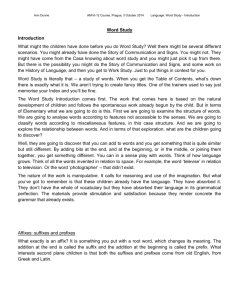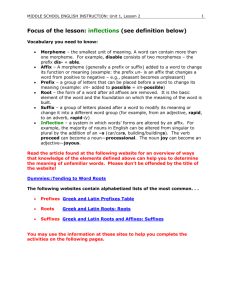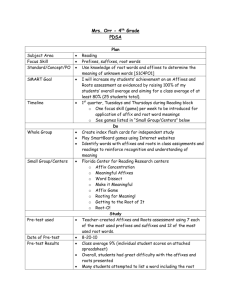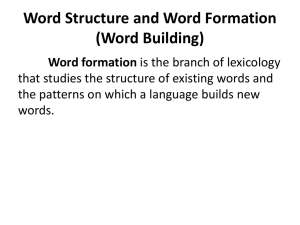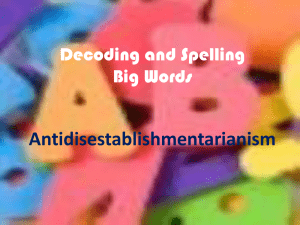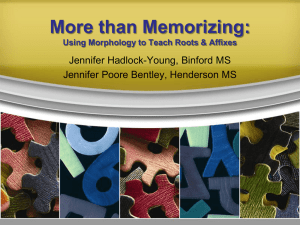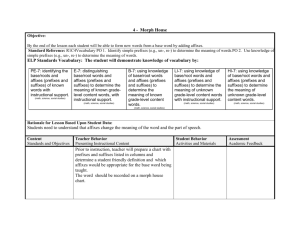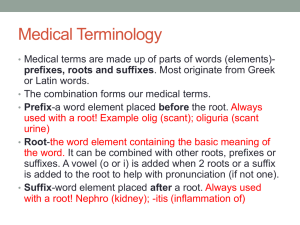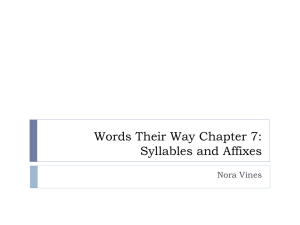Morphographic Approaches
advertisement
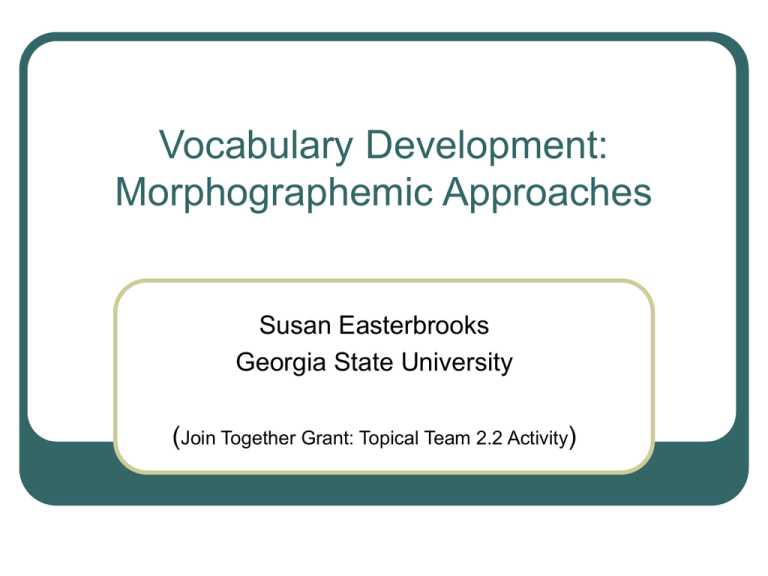
Vocabulary Development: Morphographemic Approaches Susan Easterbrooks Georgia State University (Join Together Grant: Topical Team 2.2 Activity) Word meanings are expanded, modified, and changed routinely by affixing single and multiple morphemes to the front or end of a root word. The word “antidisestablishmentarianism” derives from the word “establish” and is modified by two prefixes (anti-, dis-) and four suffixes (-ment, -ary, -an, -ism). (We complicate this even further with a spelling rule requiring us to change the y in –ary.) What is a morpho-grapheme? Based on morphemes (word parts): • Root words- dog, car, at, on, just • Bound morphemes (affixes) • Prefixes (un, re, dis) • Suffixes (ly, ment, s, ness) Students learn word meanings by first writing parts of words (graphemes) and then by analyzing their meaning. Word parts are called “parts of speech”, although that is misleading. They are categories of base words. Unpack Your Adjectives, Lolly, Lolly, Lolly, Get Your Adverbs Here, Conjunction Junction, Interjections, Rufus Xavier Sarsaparilla, Verb: That's What's Happening, A Noun is a Person, Place or Thing, Busy Prepositions, The Tale of Mr. Morton http://www.klise.com/learn/grammar/pos. htm Examples of affixes attached to root/base words Ease • • • • • Eased Easy Easier Easiness Easement • • Disease Uneasy Teach • • • Teaches Teacher Teaching • • • Reteach Preteach Unteach Morphographemic instruction requires the use of SEE prefix and suffix signs. Similar to “structural analysis” Structural Analysis- • The process of identifying words by dividing them into morphemes or small meaningful units. Instruction in structural analysis generally focuses on breaking words into syllables, then identifying their base word and affixes. An affix is something you affix to a base word, as in a prefix or suffix. ALSO FOCUSES ON traditional SYLLABICATION activities. The syllable is the unit of instruction we are interested in. Sound-based. Morphographemics- • • The relationship between a meaningful unit (or morpheme) and the print unit (or grapheme) that represents it. Morphographemic analysisThe process of teaching a child to use structural analysis then to go beyond basic structural analysis to a higher level of understanding of the Latin or Greek roots of words. Focuses on the meaning of affixes and root words. The morpheme is the unit of instruction we are interested in. Meaning-based. How are these two alike? How are they different? Structural analysis includes phonics rules and structural rules. Example phonics rules • • • Break words into their consonant and vowel patterns. For example, ro/bot is made up of the VC/CVC pattern. When you see a word with VCV (obo) that is surrounded by other letters, divide between the first vowel and the consonant to its right. When a two consonants occurs in a word, we usually divide between them as in rab/bit or win/dow. We do not divide two consonants when they form a digraph as in no/where. When le is at the end of a word and it is preceded by a consonant, divide the word before the preceding consonant as in ap/ple, or ta/ble. Example syllabication (structural) rules • Divide between two roots in a compound word as in • • • • any/body, or cup/cake. Divide between roots and suffixes as in pay/ment or govern/ment. Divide between prefixes and roots as in un/happy or im/mature. Divide between verb and verb inflections such as walk/ing. Sound out words first. Just because they have a verb ending does not necessarily mean they have more than one syllable as in jumped Morphographemic analysis is effective with deaf students because: The patterns of letters are visually mediated and are thus available to the deaf student. You see and sign them, not necessarily say them. Morphographic correspondence in English is more stable and therefore more reliable than graphophonemic correspondence. Ability to apply syntactic knowledge to decoding text is highly correlated with comprehension performance of good readers who are deaf (Kelly, 1995). Skilled readers who are deaf pay attention to form features of English text more so than poor readers. Strong evidence exists for the role of a large vocabulary in reading proficiency, and manipulation of morphological forms is critical to development of more advanced vocabulary. Spellings derived from morphographemic analysis are more stable than spelling from phonic analysis. 13 Rules for Teaching Morphographs 1. Embed decoding of the target (e.g., ambi) into meaningful print to ensure comprehension. 2. Teach students to decode unknown vocabulary in the context of known grammar and vocabulary. You want to give them as many context cues a possible. 3. Teach morphographemes by visually highlighting the changes they make to base or root words or to other morphographs (e.g., happy versus unhappy). 4. Teach basic verb inflections (-ing, -er, -s, etc.) 5. Next, teach prefixes, suffixes, and compound words. 6. Next, teach Latin roots for numbers as they are most easy to demonstrate visually. They also are among the Latin prefixes/roots that will allow you to demonstrate the largest number of derived words. For example, "turb" means "to agitate" and gives us such words as "perturbed" or "turbulence", but "uni" means "one" and gives us a much longer list (e.g., universe, universal, university, unicycle, unity, unite, unicorn, union, unison, unit, uniform, united, unitary, unisex, unicelluar). 7. Next, teach base word meanings such as -turb and -script. Some base words cannot stand alone. 8. To teach Latin and Greek affixes and roots, focus on recognition of the meaning of a root or affix as in: • How many feet does this creature have? • • • • • • • • unipod biped tripod quadruped hexapod octopod centipede millepede 9. Teach within the context of created sentence groups. For example, when teaching the meaning of "unicycle" (assuming that the child knows that "uni" means "one“), tell a story where the root "cycle" clearly appears elsewhere in the passage. (When I was little, I had a tricycle. My parents bought me a bicycle when I was six years old. One day, when I am brave enough, I want to learn to ride a unicycle. What does unicycle mean?) 10. Teach all possible derived forms of a word to show the possible ways an affix can change the meaning and grammatical category, helping students examine all the different words that can be derived from one base. This is a teacher-directed activity. e.g., scrip/scrib (to write) nouns scripture description manuscript prescription scriber script inscription verbs scribe (d, ing) describe inscribe prescribe scribble adjectives scribed scribbled prescribed 11. Next, have students brainstorm as many words as possible with a given affix or root (e.g., cycle, bicycle, unicycle, cyclical). This is a student-directed activity. The teacher might give students passages in books that have the root. graph= write graphic, grapheme, autograph, telegraph, biography, calligraphy cent= 10 or middle cent, central, centrifugal, centimeter, century 12. Source: Paul, P. (1998). Literacy and deafness. Boston: Allyn & Bacon Paul recommends a table of combing charts after students have a lot of experience with word parts. Which words in the columns can be combined with which prefixes in the rows? Table of Combing Parts gon ton cycl (angle) (pitch) (wheel) mono (1) X bi, di (2) tri (3) oct (8) gam angl (marriage) (angle) X dec (10) poly (many) ped/pod enni/annu (foot) (year) 13- Have student use the Table of Combining Parts to complete the following matching exercises Activity A 1. 2. 3. 4. 5. 6. 7. Monotonous Monocycle Monogamy Polygamy Bigonial Bicycle Bigamist ___a. having two angles ___b. having only one spouse ___c. marrying several persons ___d. a person who has two spouses at the same time ___e. always the same ___f. one-wheeled vehicle ___g. two-wheeled vehicle Activity B 1. 2. 3. 4. 5. 6. 7. biannual quadricycle biangular tricycle trigamist triangle triennial ___a. three-angled figure ___b. every third year ___c. three-wheeled vehicle ___d. having two angles ___e. person having three wives at once ___f. happens twice a year ___g. four-wheeled vehicle Activity C 1. 2. 3. 4. 5. 6. 7. monopod biped decapod hexapod tripod octopus quadruped ___a. a horse ___b. three-legged stand ___c. has eight feet (tentacles) ___d. a person ___e. an insect with six legs ___f. having one foot ___g. lobster or crayfish with 10 legs Teaching Tips Remember to use visual and context cues as often as possible. Include advance organizers where possible. Supplement with higher-level comprehension strategies (e.g., what to expect from certain kinds of books, activation of prior knowledge, etc). Use visual organizers to help students apply new words. Identify word Meaning 1 Verb endings -s Prefixes -ed Suffixes Meaning 2 Verb endings Prefixes Suffixes Incorporate work into stories, such as this example. In this story, Sir Cumference must make a round table. With the support of his wife, Lady Di, and son, Radius, he successfully measures the table. The diameter of the table measures exactly as tall as Lady Di, and the radius is exactly as tall as their son. It is a cute and clever story and excellent for introducing morphographemic work. Concepts you can develop in this story • Circum= around, about, on all sides, surrounding • • • • • • • • • Circumnavigate Circumscribe Circumfuse Circumambulate Circumspection Circumvent Circumstantial Circumlocution Circumnavigate Other Resources http://www.kent.k12.wa.us/KSD/MA/resources/ greek_and_latin_roots/transition.html (list of Greek and Latin roots and affixes) Orton-Gillingham Institute http://www.strugglingreaders.com/html/GA122. htm
